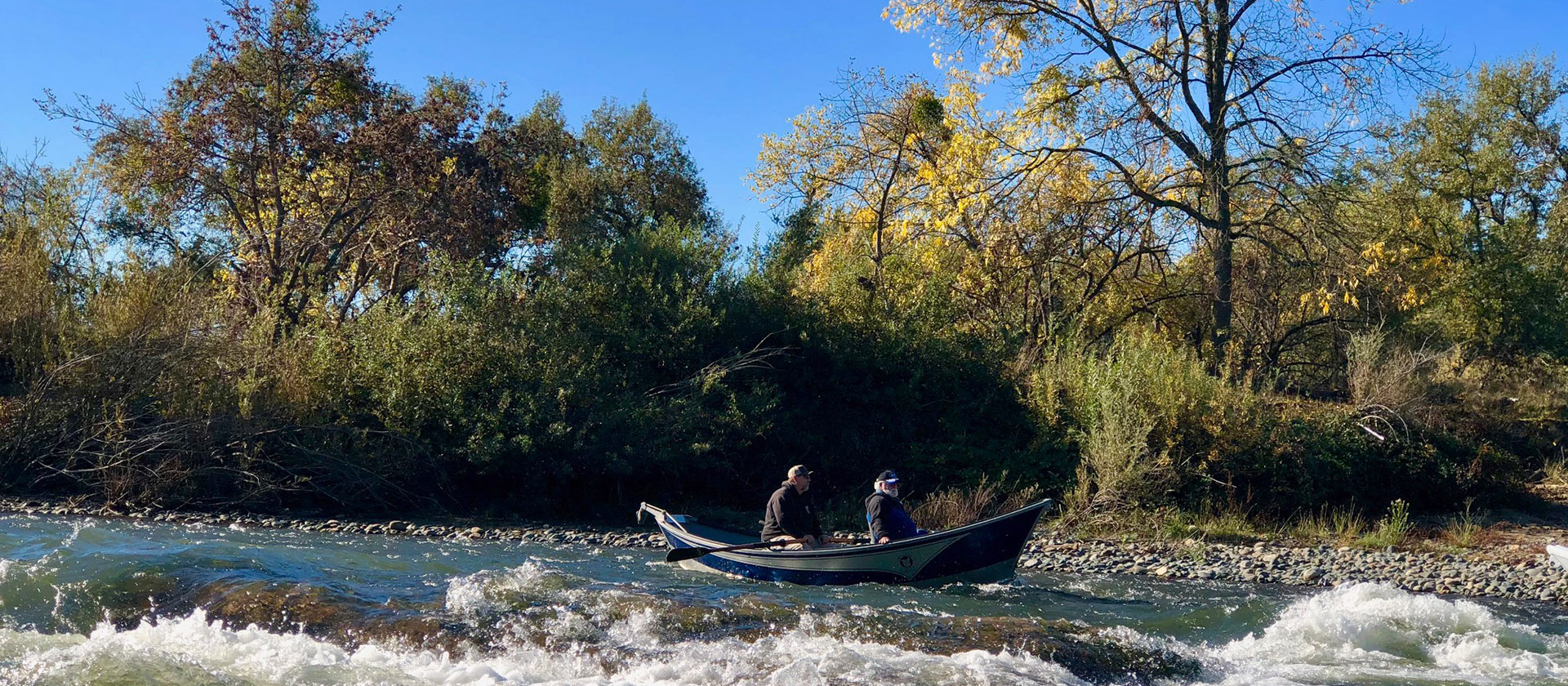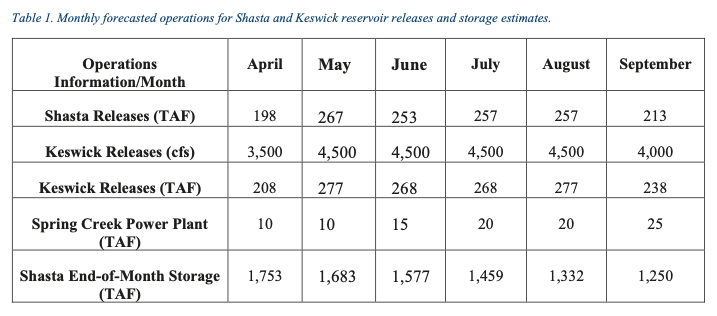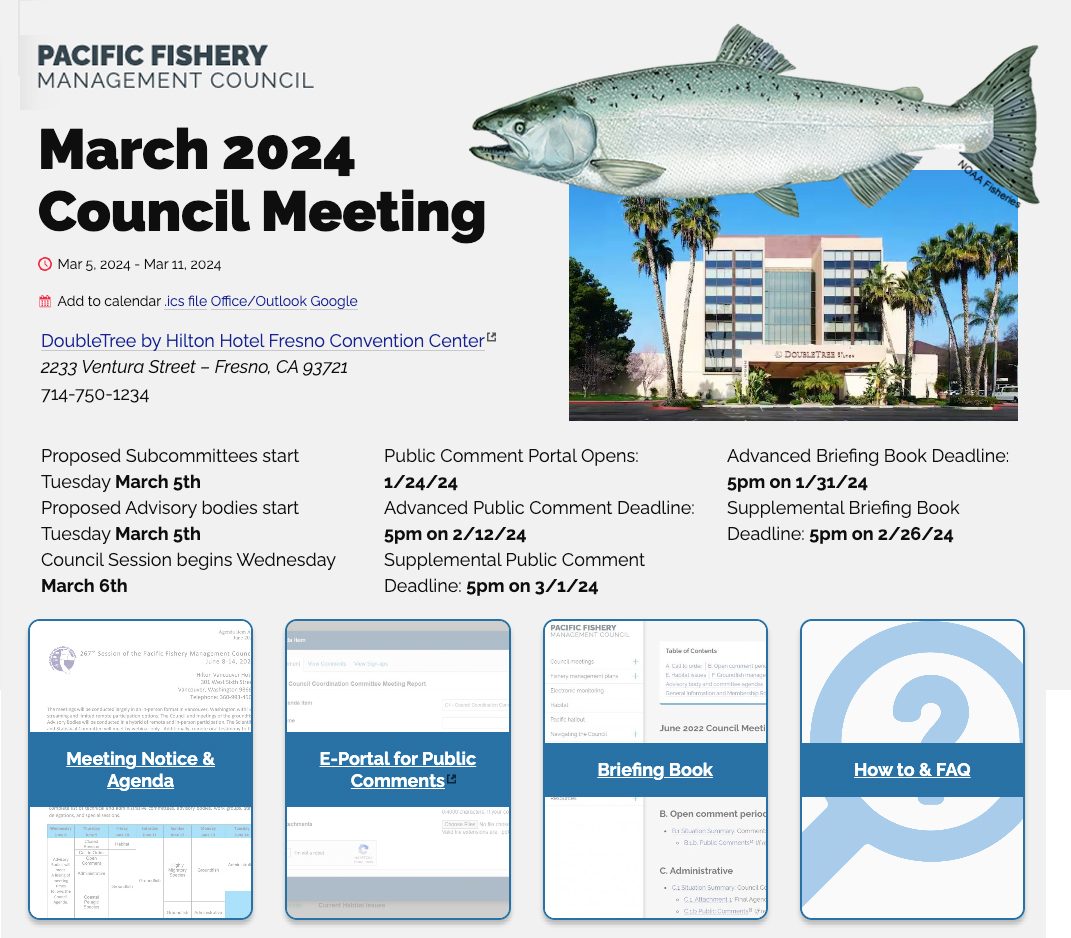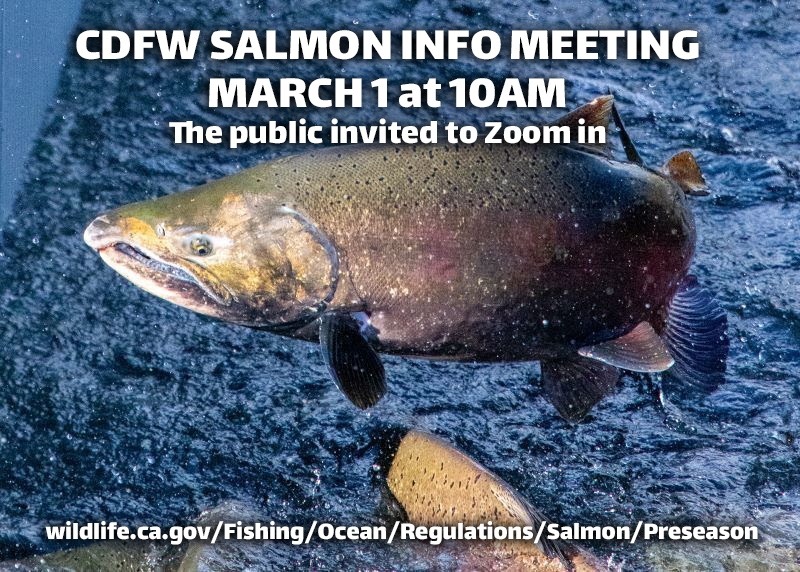Sacramento River Temperature Management Plan for Water Year 2022
CLICK HERE for full PDF to download.
Conditions in the Central Valley are critically dry, and consequently, Shasta temperature management is limited by these dry conditions. Water year 2022 is also following a critically dry year in 2021 and a dry year in 2020. This year also had the driest January through March period on record. The Northern Sierra Precipitation 8-Station Index indicates that this year’s hydrologic conditions are nearly 20 inches less than average. In mid-March, Shasta Reservoir’s cold water pool used to protect winter-run Chinook salmon was projected to be comparable to other drought years such as 2014, 2015 and 2021.
This temperature management plan includes many assumptions of drought actions in order to reach the forecasted Shasta and Keswick monthly releases; however, many of these actions are system-wide rather than specific temperature actions and are therefore not included in this report.
This Water Year 2022 Sacramento River Temperature Management Plan (Plan) reflects coordination starting in February 2022 to manage operations of Shasta Reservoir for water temperatures on the Sacramento River using conservative assumptions in modeling, taking advantage of opportunities to increase the cold water pool, and managing to real-time conditions. The Plan describes how the U.S. Bureau of Reclamation (Reclamation) plans to operate Shasta Reservoir and the Temperature Control Device (TCD) on Shasta Dam consistent with the 2020 Record of Decision on the Coordinated Long-Term Operation of the Central Valley Project and State Water Project (LTO) in compliance with:
- RPM 1.a. of the 2019 National Marine Fisheries Service (NMFS) Biological Opinion to, in coordination with the Sacramento River Temperature Task Group (SRTTG), consider technical assistance from NMFS regarding the development of an annual temperature management plan and to submit a final temperature management plan to NMFS by May 20 of each year;
- Order 90-5 to consult with the California Department of Fish and Wildlife (CDFW), U.S. Fish and Wildlife Service (USFWS), NMFS, and Western Area Power Administration on the designation of a location upstream of the Red Bluff Diversion Dam where Reclamation will meet a daily average water temperature of 56°F; and
- Order 90-5 to provide an operation plan to the State Water Resources Control Board (SWRCB), Chief of the Division of Water Rights, on Reclamation’s strategy to meet the temperature requirement at a location upstream of the Red Bluff Diversion Dam.
- The Interim Operations Plan (IOP), ordered by the US District Court on March 14, 2022, which identified priorities and planning efforts for Shasta cold water pool management to meet operational priorities and species needs. This IOP included establishing a six-agency Shasta Planning Group (SPG) to work iteratively with the technical groups (e.g., SRTTG and USST) to solicit operational guidance and risk assessments and provide policy guidance as necessary.
- Temporary Urgency Change Order(TUCO) dated April 4, 2022The Plan establishes temperature locations and targets through October 31, and estimates winter-run Chinook salmon egg mortality, dates for operation of the side gates on the TCD, and end of September cold water pool. Reclamation will monitor the cold water pool, compare measured conditions to actual
1
DRAFT April 6, 2022
DRAFT April 6, 2022
performance during implementation, and provide regular updates through the SRTTG throughout Plan implementation.
Based on the February 90% forecast, Reclamation identified that Water Year 2022 was likely to be a Tier 4 year. In a Tier 4 year, there is less than 2.5 MAF of total storage in Shasta Reservoir at the beginning of May, and/or Reclamation cannot meet 56°F at CCR. Conditions on March 1 along with modeling based on measured reservoir profiles confirm that WY2022 is a Tier 4 temperature management season.
MODELING ASSUMPTIONS, LIMITATIONS, AND OTHER UNCERTAINTIES
A seasonal water temperature forecast describes future expected downstream water temperature. This forecast, or simulation of expected water temperature performance is based on the targets specified in the TMP. Future water temperature is forecasted using computational tools, at various elevations in the reservoirs and downstream in the river. These tools are based on conservative assumptions regarding hydrology, operations, and meteorology. Because this forecast (using conservative estimates in March to estimate what might happen at the end of October) can never exactly predict the actual hydrology, operations, and meteorology, the model results are not expected to precisely match actual water temperatures. The expectation is, however, that forecasted downstream water temperatures generally have an accepted measure of error regardless of the uncertain future conditions. In this case, there are generally two types of simulation error; uncertainty of the future conditions (e.g. inputs such as meteorology) and inherent model error or bias. To better understand the inherent model error or bias, a hindcast evaluation is typically performed. A hindcast, rather than looking forward to forecast, simply uses the actual input/forcing data after it’s observed (e.g. hydrology, operations, and meteorology) to determine how well the model reproduced a condition such as actual downstream water temperatures.
Reclamation has proposed the use of NOAA-NWS Local Three-Month Temperature Outlooks (L3MTO) and historical meteorology as a means of estimating air temperature expectations for modeling purposes. In coordination with SRTTG, Reclamation has the choice of five exceedance threshold options, varying from those that serve more conservative stream temperature planning (e.g., 10% exceedance) to those that serve more aggressive planning (e.g., 90% exceedance). In past years, SRTTG has recommended the use of a conservative approach that uses the 25% exceedance L3MTO forecast. However, this approach is not available in March and Reclamation plans to apply this forecast beginning in April. Reclamation’s March model runs utilized historical 25% exceedance meteorology.
RELEASE OUTLOOK
The Shasta Reservoir release strategy included in this plan and temperature modeling relies on numerous drought actions throughout the Sacramento and San Joaquin watersheds to reduce reliance on stored water from CVP and SWP reservoirs this summer. These drought actions have added a degree of flexibility to manage storage at Shasta, Oroville and Folsom reservoirs for meeting public health and safety needs, repelling salinity in the delta, producing hydropower and providing additional cold water for fishery protection throughout the summer. This release schedule is intended to guide the monthly average releases from Keswick Dam. Daily releases may vary from these flows to adjust for real-time operations. Trinity River releases below Lewiston Dam were based on a forecasted Critical Year type and diversions through Carr Powerplant were adjusted to balance flow and water temperature goals. Significant uncertainties exist within the forecast that will require intensive real-time operations management throughout the summer to achieve the various goals and targets throughout the system. Reclamation commits to reporting out on the status of this release outlook, temperature management and overall system operations at the weekly WOMT meeting. Table 1 describes the monthly forecasted operations for releases and storage targets which were taken from the March 90% CVP forecast of operation (Attachment 1).








